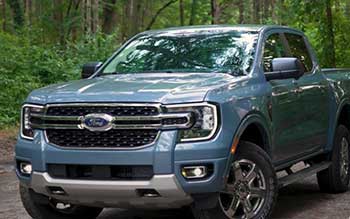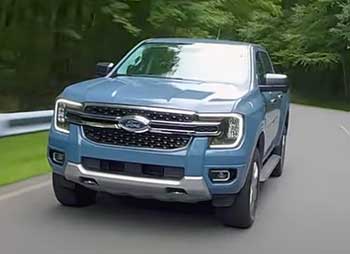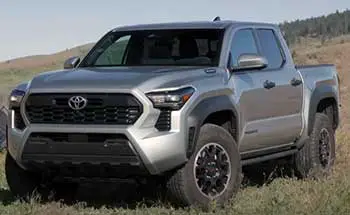
I’ve always been drawn to the rugged charm of midsize pickup trucks, and when it came time to choose between the 2025 Ford Ranger and the 2025 Toyota Tacoma, I knew I was in for a tough decision.
Both trucks dominate the midsize segment with their blend of power, versatility, and off-road prowess.
My goal here is to share my firsthand experience with these trucks, breaking down their strengths, weaknesses, and maintenance needs while comparing them head-to-head. Whether you’re hauling gear, hitting the trails, or cruising highways, I’ll help you figure out which truck suits your lifestyle.
Comparison Table
| Feature | Ford Ranger (2025) | Toyota Tacoma (2025) |
|---|---|---|
| Base Price | ~$34,000 | ~$32,000 |
| Engine Options | 2.3L Turbo I-4 (270 hp), 2.7L Turbo V6 (315 hp), 3.0L Turbo V6 (405 hp, Raptor) | 2.4L Turbo I-4 (228-278 hp), i-FORCE MAX Hybrid (326 hp, 465 lb-ft) |
| Towing Capacity | Up to 7,500 lbs | Up to 6,500 lbs |
| Payload Capacity | Up to 1,805 lbs | Up to 1,710 lbs |
| Fuel Economy | 21 MPG city, 25 MPG highway (base) | 18-24 MPG (depending on trim) |
| Transmission | 10-speed automatic | 8-speed automatic, 6-speed manual (select trims) |
| Off-Road Trims | Raptor, Tremor | TRD Pro, TRD Off-Road, Trailhunter |
| Safety Features | Co-Pilot360 (not standard on all trims) | Toyota Safety Sense 3.0 (standard) |
| Interior Tech | 10.1-inch touchscreen, 8-inch gauge cluster | 8-14-inch touchscreen, 7-12.3-inch cluster |
| Ground Clearance | 8.4-9.7 inches (model-dependent) | Up to 9.4 inches (TRD Off-Road) |
My Experience With The Ford Ranger
I hopped into the 2025 Ford Ranger with high expectations, given its reputation as a versatile midsize truck. My test drive included the XLT 4×4 and the off-road-ready Raptor, and I was impressed by the Ranger’s balance of power and comfort. The 2.3-liter EcoBoost engine felt punchy, delivering 270 horsepower that made merging onto highways a breeze.
The Raptor’s 3.0-liter V6, with 405 horsepower, was a beast, especially on rough trails where its FOX shocks soaked up bumps like they were nothing. The cabin felt spacious, especially in the SuperCrew configuration, with supportive seats and a modern 10.1-inch touchscreen that was intuitive to use.
On the road, the Ranger’s ride was smooth and quiet, making it a great highway cruiser for my 80-mile daily commute. The 10-speed automatic transmission shifted seamlessly, and I appreciated the high-mounted driver’s seat for better visibility.
Off-road, the Raptor’s skid plates and 33-inch tires tackled rocky paths with confidence, though I noticed the steering felt a bit vague at times, especially in tighter turns. The Ranger’s towing capacity of 7,500 pounds came in handy when I hauled a trailer full of landscaping supplies, and it handled the load without breaking a sweat.
However, the Ranger wasn’t flawless. The base XL trim’s interior felt a bit spartan, with vinyl floors and a smaller 4.2-inch non-touchscreen display that seemed outdated. The back seat, while roomy, lacked the foldable flexibility of some competitors, and the beige cloth seats in the XLT were already showing stains after a weekend of muddy boots.
I also found the Ranger’s fuel economy—21 MPG city and 25 MPG highway—decent but not class-leading, especially when towing. The National Highway Traffic Safety Administration (NHTSA) gave it a four-star overall safety rating, dragged down by a three-star rollover score, which gave me pause.
Pros Of The Ford Ranger

- Powerful Engine Options: The Ranger’s 2.3-liter turbo (270 hp) and optional 2.7-liter V6 (315 hp) provide strong acceleration, and the Raptor’s 3.0-liter V6 (405 hp) is a standout for performance enthusiasts. These engines make towing and passing on highways effortless.
- Impressive Towing and Payload: With a max towing capacity of 7,500 pounds and payload up to 1,805 pounds, the Ranger outperforms most midsize rivals, perfect for hauling heavy loads like trailers or equipment.
- Comfortable Ride Quality: The Ranger’s suspension delivers a smooth, quiet ride, especially on highways, making it ideal for long commutes or road trips. The high-mounted seats add to driver comfort and visibility.
- Advanced Technology: The 10.1-inch touchscreen and 8-inch digital gauge cluster (standard on most trims) are user-friendly, with wireless Apple CarPlay and Android Auto. The optional 12-inch touchscreen in higher trims feels cutting-edge.
- Off-Road Capability: The Raptor and Tremor trims shine off-road with FOX shocks, skid plates, and 33-inch tires, handling rugged terrain with ease. The Ranger’s global platform, designed by Ford Australia, adds durability.
Also read: My Thoughts on Ford Edge Vs. Hyundai Tucson.
Cons Of The Ford Ranger
- Base Trim Lacks Refinement: The XL trim’s vinyl floors and 4.2-inch non-touchscreen display feel cheap compared to competitors’ base models, which offer more standard tech.
- Rollover Safety Concerns: The Ranger’s three-star NHTSA rollover rating is a weak point, especially for a truck marketed for off-road adventures where stability is key.
- Limited Rear Seat Flexibility: The back seat cushion lifts as one piece, unlike competitors with split-folding designs, limiting cargo versatility when carrying passengers.
- Steering Feedback: Some drivers, including me, found the steering vague, particularly in off-road scenarios or tight maneuvers, which can reduce confidence.
- Higher Maintenance Costs: Annual maintenance averages $615, higher than some rivals, and long-term reliability is less proven compared to Toyota’s track record.
Maintenance Tips For the Ford Ranger
- Regular Oil Changes: The EcoBoost engines require synthetic oil changes every 7,500-10,000 miles to maintain turbo performance. I stick to Ford’s recommended 5W-30 oil to avoid engine wear.
- Tire Rotations: Rotate tires every 6,000 miles to ensure even wear, especially if you’re off-roading with the Raptor’s 33-inch tires, which can be pricey to replace.
- Check Transmission Fluid: The 10-speed automatic needs fluid checks every 30,000 miles. I noticed smoother shifts after a flush at 60,000 miles on a friend’s older Ranger.
- Inspect Skid Plates: Off-roaders should check skid plates for dents or loose bolts after rough trails. I found a loose bolt on the Raptor after a rocky climb, which was an easy fix.
- Monitor Brake Pads: The Ranger’s brakes wear faster when towing heavy loads. Inspect pads every 20,000 miles and replace them if they’re below 3mm to avoid rotor damage.
- Battery Maintenance: The Ranger’s stop-start system can strain the battery. I clean terminals annually and test the battery every two years to prevent unexpected failures.
My Experience With The Toyota Tacoma
The 2025 Toyota Tacoma felt like a breath of fresh air when I slid behind the wheel of the TRD Sport and TRD Pro models. The redesigned fourth-generation Tacoma, built on the TNGA-F platform, felt solid and modern.
The base 2.4-liter turbo-four engine (228-278 hp) was adequate but not thrilling, but the i-FORCE MAX hybrid (326 hp, 465 lb-ft) in the TRD Pro was a game-changer, offering torque that rivaled full-size trucks. The TRD Off-Road’s Crawl Control and Multi-Terrain Select made light work of muddy trails, and the 9.4-inch ground clearance helped me clear obstacles without scraping.
The Tacoma’s interior was a mixed bag. The TRD Sport’s 8-inch touchscreen and 7-inch gauge cluster were functional, but the 14-inch touchscreen in the TRD Pro felt like a luxury SUV. The seats, though supportive, used hard padding that wasn’t ideal for long drives, and the rear seat’s tight legroom made it better suited for kids or cargo.
On highways, the Tacoma was noisier than the Ranger, with noticeable wind and road noise, but the available six-speed manual transmission added a fun, old-school vibe for stick-shift fans like me.
Towing 6,500 pounds was no issue, though it lagged behind the Ranger’s capacity. The Tacoma’s fuel economy (18-24 MPG) was slightly worse than the Ranger’s, but the hybrid option improved efficiency. Safety-wise, Toyota Safety Sense 3.0 came standard across all trims, earning a Top Safety Pick from the IIHS, which gave me peace of mind.
However, the Tacoma’s plasticky interior trim and switch blanks in higher trims felt like cost-cutting, and the four-cylinder engine felt underpowered compared to the Ranger’s turbo.
Pros Of The Toyota Tacoma

- Legendary Reliability: The Tacoma’s reputation for lasting 300,000+ miles is unmatched, with J.D. Power giving the 2023 model an 83/100 reliability score, just behind the Ranger’s 86.
- Off-Road Versatility: TRD Pro, TRD Off-Road, and Trailhunter trims offer Crawl Control, Multi-Terrain Select, and skid plates, making the Tacoma a top choice for serious off-roaders.
- Hybrid Powertrain: The i-FORCE MAX hybrid (326 hp, 465 lb-ft) delivers class-leading torque and better fuel economy, ideal for eco-conscious truck buyers.
- Manual Transmission Option: Select trims offer a six-speed manual, a rarity in modern trucks, appealing to enthusiasts who love a hands-on driving experience.
- Standard Safety Features: Toyota Safety Sense 3.0, with adaptive cruise control, lane departure warning, and automatic emergency braking, is standard on all trims, unlike the Ranger’s optional Co-Pilot360.
Cons Of The Toyota Tacoma
- Noisy Cabin: Road and wind noise were noticeable, especially at highway speeds, making the Tacoma less refined than the Ranger for long drives.
- Cramped Rear Seat: The Double Cab’s rear legroom is tight, better suited for kids or cargo than adult passengers, limiting family-friendly appeal.
- Underpowered Base Engine: The 2.4-liter turbo-four (228 hp) feels sluggish compared to the Ranger’s base engine, especially when loaded or towing.
- Plasticky Interior: Higher trims have cheap-feeling plastic trim and switch blanks, which detract from the premium feel expected at $45,000+ price points.
- Lower Towing Capacity: Maxing out at 6,500 pounds, the Tacoma trails the Ranger’s 7,500-pound capacity, a drawback for heavy-duty tasks.
Maintenance Tips For The Toyota Tacoma
- Engine Oil Checks: The 2.4-liter turbo engine needs oil changes every 7,500 miles with 0W-20 synthetic oil. I check levels monthly, as turbos can be sensitive to low oil.
- Air Filter Replacement: Off-roaders should replace the air filter every 15,000 miles or sooner if driving in dusty conditions to maintain engine efficiency.
- Differential Fluid: Check and replace differential fluid every 30,000 miles, especially for 4×4 models, to prevent wear on off-road components.
- Coolant Flush: The hybrid system in the i-FORCE MAX requires a coolant flush every 100,000 miles. I mark my calendar to avoid overheating issues.
- Suspension Inspection: TRD models’ Bilstein shocks need inspection every 50,000 miles. I had a loose bolt tightened after a trail run to prevent rattling.
- Rust Prevention: The Tacoma’s frame is prone to rust in humid climates. I apply an undercoating annually and wash the undercarriage after off-roading.
Comparison With Other Brands
- Chevrolet Colorado: The 2024 Colorado, MotorTrend’s Truck of the Year, offers a refined ride and a 2.7-liter turbo-four (237-310 hp) that matches the Ranger’s power. Its interior feels upscale, but it lacks the Tacoma’s hybrid option and manual transmission. Towing (7,700 lbs) beats both, but off-road trims like the ZR2 are pricier than the Tacoma TRD Pro or Ranger Raptor.
- Honda Ridgeline: The Ridgeline’s unibody design delivers a car-like ride, ideal for urban drivers, with 280 hp and 5,000-pound towing. It’s less capable off-road than the Tacoma or Ranger and lacks their rugged appeal, but its spacious cabin and clever storage make it a practical alternative.
- Nissan Frontier: The Frontier’s 3.8-liter V6 (310 hp) offers strong power, and its 6,720-pound towing capacity splits the difference between the Ranger and Tacoma. Its interior feels dated, and it lacks a hybrid option, but its lower starting price (~$31,000) and solid reliability make it a budget-friendly rival.
- Jeep Gladiator: The Gladiator’s 3.6-liter V6 (285 hp) and 7,700-pound towing match the Colorado, but its off-road prowess rivals the Tacoma TRD Pro. Its frame durability concerns and higher price (~$39,000) make it less practical for daily driving compared to the Ranger or Tacoma.
Read more: My Thoughts on GMC Terrain Vs. Ford Escape.
Frequently Asked Questions (Faq)
The Ranger’s main weaknesses are its three-star NHTSA rollover rating, vague steering, and higher maintenance costs ($615/year). The base XL trim also feels under-equipped with a dated 4.2-inch display.
Yes, the Tacoma is slightly larger. The 2025 Tacoma measures about 213 inches long, while the Ranger is around 210.6 inches. Bed options vary, with the Tacoma offering 60.3- or 73.5-inch beds versus the Ranger’s 59.6-inch bed.
The Toyota Tacoma is the direct equivalent to the Ford Ranger in the midsize truck segment, competing in price, capability, and off-road performance, with trims like TRD Pro matching the Ranger Raptor.
The Ranger is reliable, with a J.D. Power score of 86/100 for 2023, slightly above the Tacoma’s 83. It can last 200,000-300,000 miles with proper care, though long-term durability is less proven than the Tacoma’s.
Conclusion: For Your Next Truck
Choosing between the Ford Ranger and Toyota Tacoma depends on what you value most. If you prioritize power, towing, and a quiet, comfortable ride, the Ranger’s robust engines and spacious cabin make it a strong contender. Its higher towing capacity and tech-forward interior are perfect for workhorses or highway cruisers.
However, if reliability, off-road versatility, and a hybrid option are your priorities, the Tacoma’s proven durability, manual transmission, and TRD trims deliver. Both trucks are fantastic, but your lifestyle—whether it’s heavy hauling or trailblazing—will tip the scales. Test drive them and see which one feels like your perfect ride.

